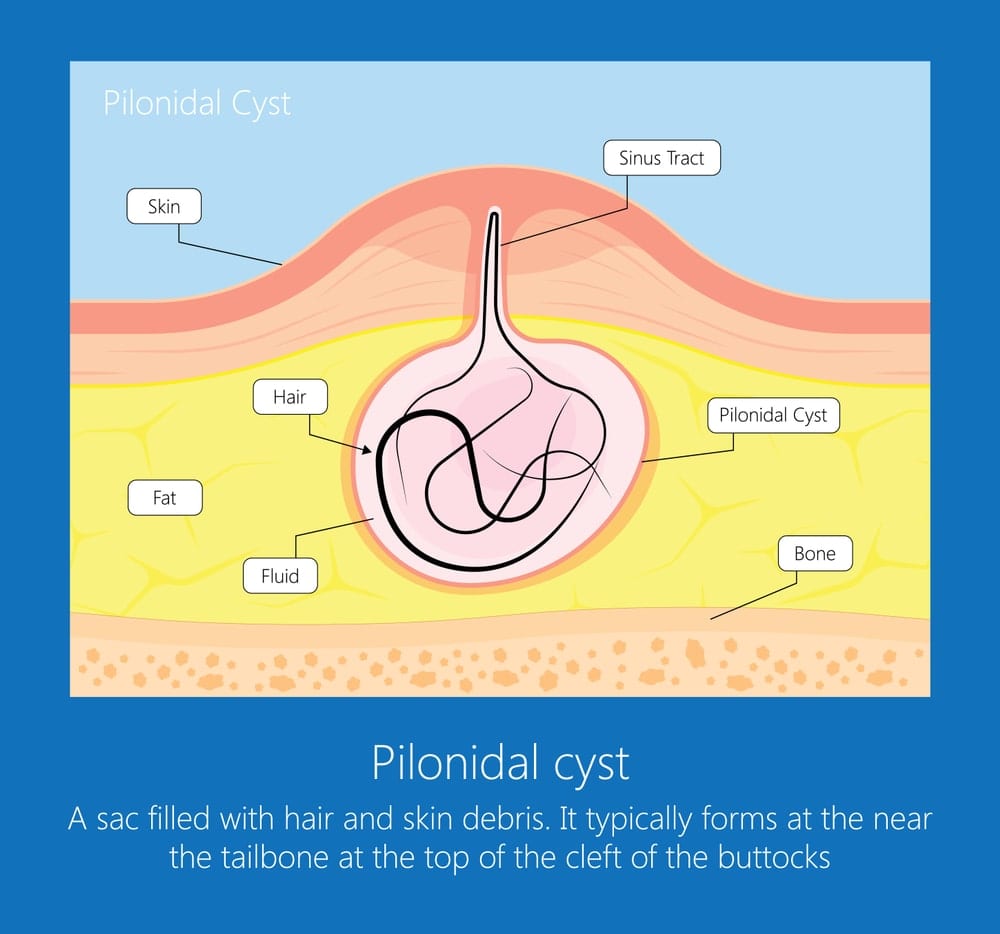Henderson Pilonidal Cyst Removal
What Is a Pilonidal Cyst?
A pilonidal cyst is a round, fluid-filled cavity in the skin tissue. It usually occurs on or around the tailbone region, just above the buttocks. The cyst is caused by the entrapment of hair, dirt and cell debris in the skin tissue. When left untreated, it can cause extreme discomfort and progress into a pus-filled abscess as a result of infection. A contaminated cyst might leak foul smelling pus or blood. Pilonidal cyst removal typically entails draining the cyst to relieve symptoms and avoid recurrence. Henderson pilonidal cyst specialist Dr. Chanu Dasari can accurately diagnose and treat pilonidal cysts. Dr. Dasari is an affiliate of Henderson hospital, and is proficient in numerous surgical techniques of pilonidal cysts and other conditions.
Signs That You May Have a Pilonidal Cyst
You may not have any evident symptoms at first besides a small, dimple-like depression on the surface of your skin. This depression may grow into a lump when it becomes infected, which can vary in size. If it does become infected, you may experience the following symptoms:
- Pain when sitting or lying down
- Swelling and inflammation near the tailbone
- Tenderness to the touch
- Low-grade fever
- Hair protruding from cyst
- Discharge from the abscess that causes a foul odor
- Formation of small openings in the skin tissue called sinus tracts
When Is it Time to Seek Pilonidal Cyst Removal in Henderson?
Pilonidal cysts, though benign, are extremely prone to infection. An infected cyst can be a painful, consistently swelling growth that should be treated immediately. Pilonidal cysts are also notorious for recurrence; proper treatment must be performed by a medical expert in order to prevent the cyst from returning. It is essential to see a Pilonidal specialist right away if you feel any of the above symptoms to avoid long-term, debilitating complications.
Henderson Pilonidal Cyst Treatment Options
When an infected pilonidal cyst is diagnosed by your primary care doctor, it should be treated by a cyst removal surgeon as soon as possible. Most of the critical issues that can occur with pilonidal cysts are avoidable at early stages with prompt analysis, swift diagnosis, and minimally invasive surgical treatment.
Surgical treatments include:
Incision and drainage – A local anesthetic is instilled in the surgical spot before Dr. Dasari makes a small diamond-shaped cut in the patient’s lower back. This incision drains out the fluid, hair follicles, and dirt. The wound is left open and packed with gauze. The healing period can take up to 3 weeks. The regular gauze dressing would be needed until the wound is healed completely.
Advantages
- The infected cyst is drained
Disadvantages
- The dressing can be painful
- The healing process is slower than other treatment options
- May not recover completely some of the time
Flap Surgery – Advanced flap surgery may be the best treatment method for removing the pilonidal cyst and moving healthy tissue to cover the site of the surgical cut. Flap surgery reduces the chance of pilonidal cyst recurrence and has a much higher rate of wound closure than most treatment options. Large sutures are needed to remain in place for several weeks during the healing process. Sutures are typically removed during a post-op visit in Dr. Dasari’s clinic with minimal discomfort.
Laser Surgery – A 1470 nm diode laser is utilized during this treatment process. The laser treatment comprises of an excision of the pilonidal cyst area in the lower tailbone, and can also treat the inferior and superior extensions. It involves a 1cm cut instead of a flap or larger cut. Laser surgery works most effectively on medium-sized cysts only. Larger cysts can still have a risk for pilonidal cyst recurrence, and a smaller cyst may suffer from skin damage.
Advantages
- Quick surgery
Top Henderson Pilonidal Cyst Specialist Dr. Chanu Dasari
Dr. Chanu Dasari is a top surgeon in the Las Vegas area, with over a decade of experience. He is an affiliate of Henderson hospital who cares deeply about the health of his community. If you have recently noticed symptoms of a pilonidal cyst, schedule an appointment with Dr. Dasari’s Henderson clinic to see if pilonidal cyst removal is right for you. You can call Minimally Invasive Surgery at (702) 602-6600 for a consultation.










